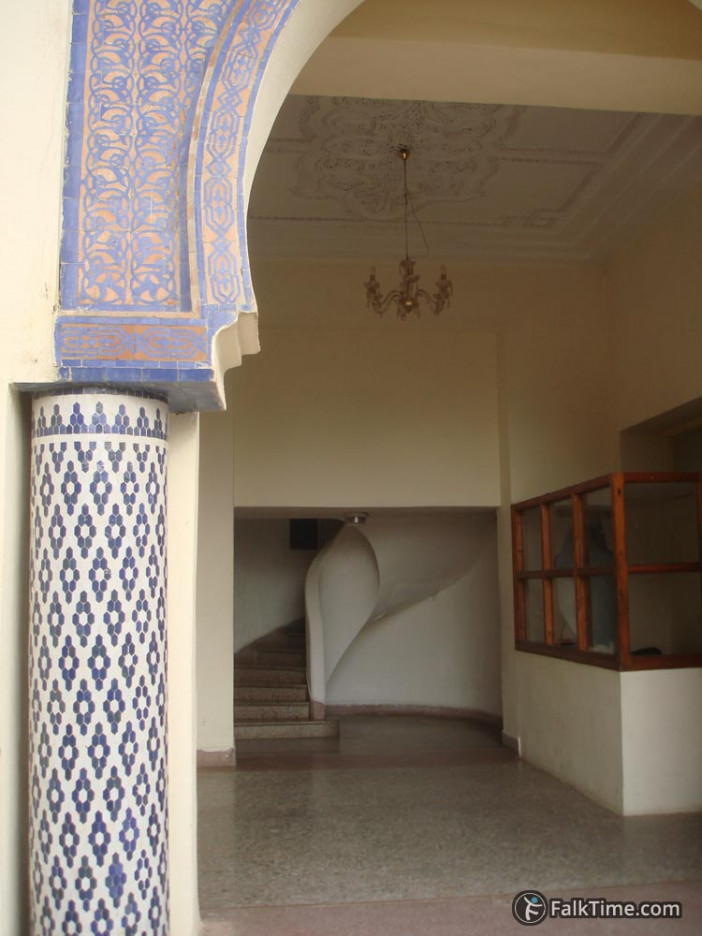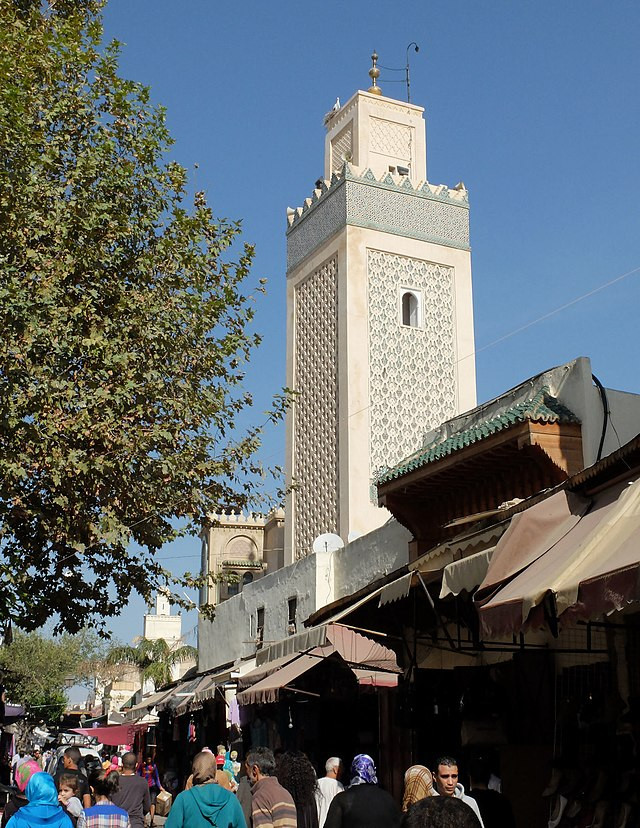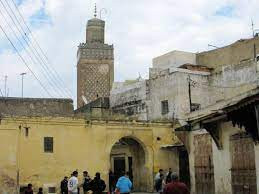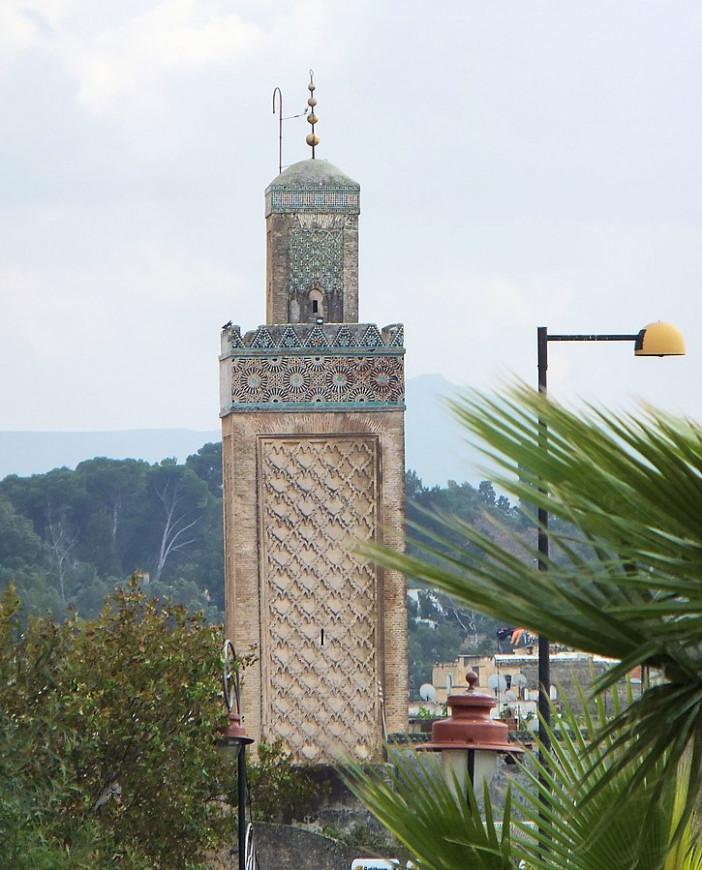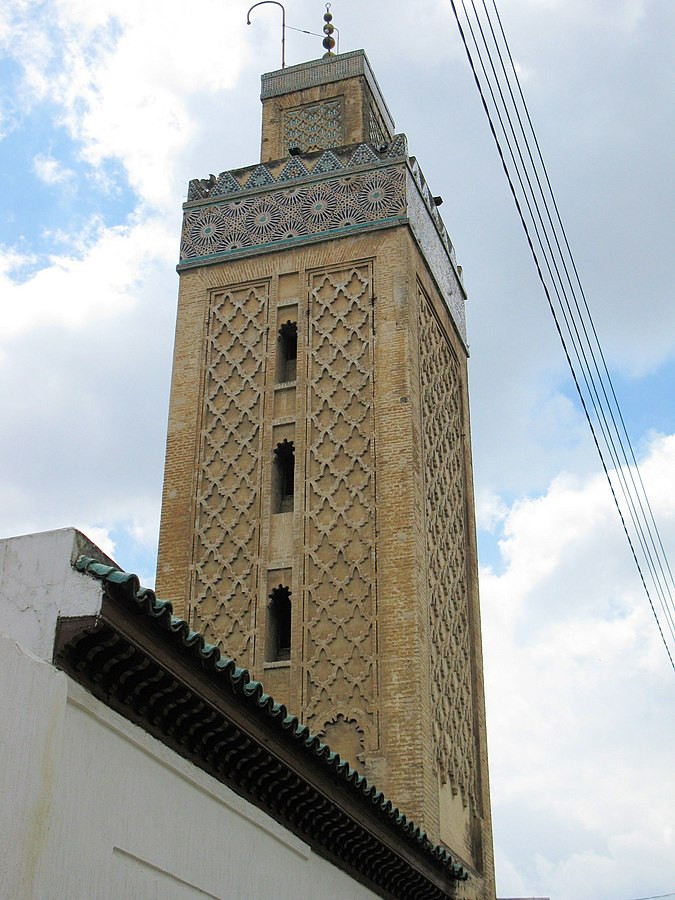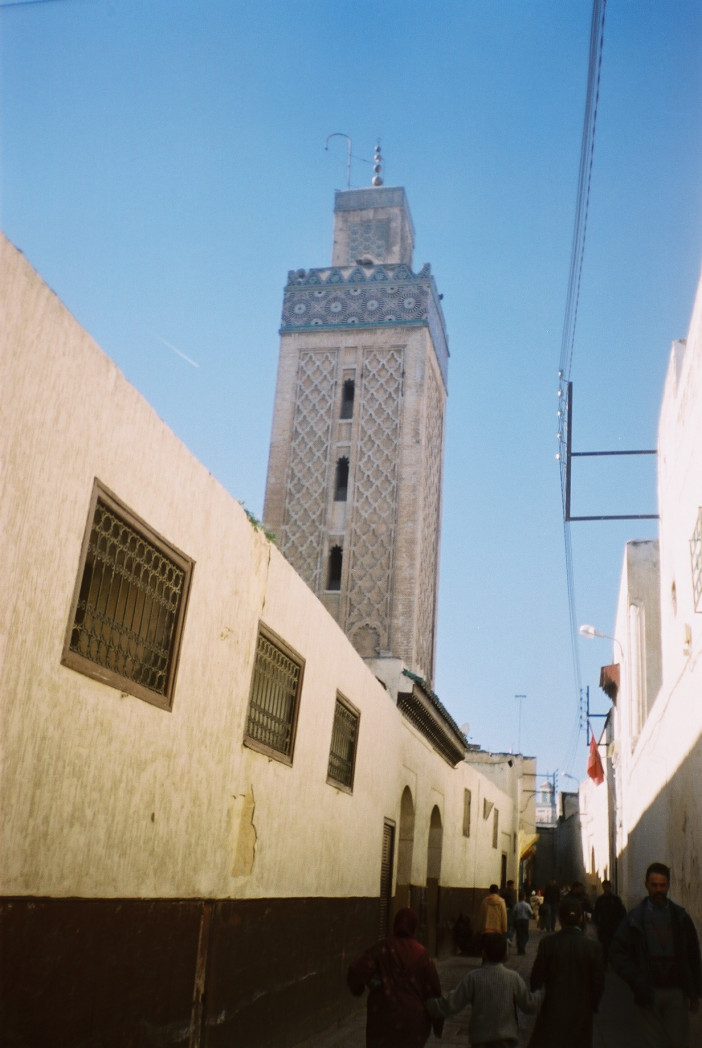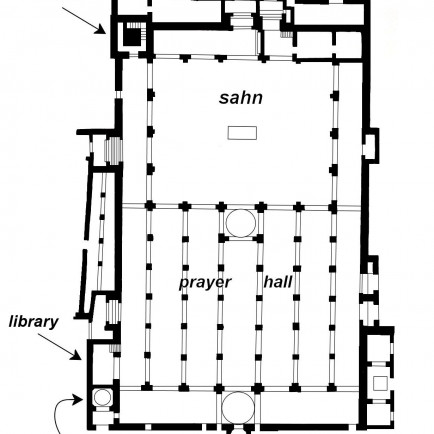Great Mosque of Fes el-Jdid
History
The mosque was built by the Marinid ruler Abu Yusuf in or around 1276, about the same time that he built the new royal capital Fes el-Jdid. Separate from Fes el-Bali (ancient Fes), where the Marinid dynasty ruled over Morocco, Fes el-Jdid was built as a fortified palace and administrative center. The governor of Meknes, Abu Ali ibn Azraq, and a man by the name of Abu Abdallah ibn Abd al-Karim el-Jadudi were given the responsibility of overseeing the mosque's construction. According to one historical account, the mosque's construction was partially supported by the production of olive oil in Meknes, while the labor was provided by Christian prisoners taken in al-Andalus (Spain). In 1278, the mosque's construction was finished.
Urban and Architectural
The overall design of the mosque is a reflection of the "T-plan" that evolved into the norm in western (Maghrebi) mosques during the Almohad era. The structure has a rectangular floor plan that is around 2000 square meters in size and is approximately 54 by 34 meters. The design features a sizable hypostyle internal prayer room and a sizable rectangular courtyard (sahn) that takes up the majority of the building's northern portion.
The main entrance to the mosque is to the north, aligned with the mihrab (see below), which is located at the other end of the structure and leads into the courtyard. The entrance is doubled; a second gate is located to the east (left) of the main gate. This is similar to how the Qarawiyyin Mosque's double northern gate, known as Bab al-Ward and Bab al-Hafa, was built, with one gate having a water channel for guests to wash their feet in before entering, and the other being a standard entry. But it appears likely that in this instance, the second gate was made to provide direct access to a walled-in gallery area in the northeastern corner of the courtyard that was designated for ladies who came to worship.
The prayer hall is a large internal hypostyle area, similar to other traditional Moroccan mosques, divided only by rows of arches that run perpendicular to the southern wall, with the exception of an additional row of arches that runs close to and parallel to the southern wall. The mihrab (a niche that represents the qibla) is located in the middle of the southern wall, which also serves as the qibla wall (the direction of prayer). The central aisle, which is aligned with the mihrab, is a bit wider than the others and is highlighted by additional stucco decoration on the walls between the rows of arches. A little cupola of muqarnas is located inside the mihrab, which is an alcove in the wall (stalactite-like carving).
Description
From the northwest corner of the mosque, the minaret rises. It has a square shaft with two portions, like the majority of Moroccan minarets: a larger main section ascending the majority of the way, followed by a second, much smaller square tower at the top. The main shaft is 22.8 meters tall and measures 5.7 meters on each side (the shaft is about exactly four times as tall as it is wide). The smaller tower at the summit is 6.4 meters tall and has a side measurement of 2.9 meters. The platform at the top of the main shaft is reached by a stairway inside the minaret that circles the tower's central core. Historically, this allowed the muezzin to reach the top to sound the call to prayer.
References
https://www.archnet.org/sites/6367
https://wiki.alquds.edu/?query=Great_Mosque_of_Fes_el-Jdid
https://earth.google.com/web/search/Great+Mosque+of+Fes+el-Jdid,+Fes,+Morocco/@34.0575748,-4.9916842,380.10382553a,857.3200093d,35y,0h,45t,0r/data=CpMBGmkSYwokMHhkOWZmNWI2ODhlYzNkNTU6MHhhNDcxYzY5YTI1NGRhMzEyGYerXtlgB0FAIThz_tyG9xPAKilHcmVhdCBNb3NxdWUgb2YgRmVzIGVsLUpkaWQsIEZlcywgTW9yb2NjbxgDIAEiJgokCTctwutackFAEdtrf1KzcEFAGWP28MFunPW_IZMuNA2VM_a_
Details
Location
3255+28G Great Mosque of Fes el-Jdid, Fes, Morocco
Worshippers
1000
Owners
Sultan Abu Yusuf
Year of Build
1276
Area
2000
Drawings
Map
History
The mosque was built by the Marinid ruler Abu Yusuf in or around 1276, about the same time that he built the new royal capital Fes el-Jdid. Separate from Fes el-Bali (ancient Fes), where the Marinid dynasty ruled over Morocco, Fes el-Jdid was built as a fortified palace and administrative center. The governor of Meknes, Abu Ali ibn Azraq, and a man by the name of Abu Abdallah ibn Abd al-Karim el-Jadudi were given the responsibility of overseeing the mosque's construction. According to one historical account, the mosque's construction was partially supported by the production of olive oil in Meknes, while the labor was provided by Christian prisoners taken in al-Andalus (Spain). In 1278, the mosque's construction was finished.
Urban and Architectural
The overall design of the mosque is a reflection of the "T-plan" that evolved into the norm in western (Maghrebi) mosques during the Almohad era. The structure has a rectangular floor plan that is around 2000 square meters in size and is approximately 54 by 34 meters. The design features a sizable hypostyle internal prayer room and a sizable rectangular courtyard (sahn) that takes up the majority of the building's northern portion.
The main entrance to the mosque is to the north, aligned with the mihrab (see below), which is located at the other end of the structure and leads into the courtyard. The entrance is doubled; a second gate is located to the east (left) of the main gate. This is similar to how the Qarawiyyin Mosque's double northern gate, known as Bab al-Ward and Bab al-Hafa, was built, with one gate having a water channel for guests to wash their feet in before entering, and the other being a standard entry. But it appears likely that in this instance, the second gate was made to provide direct access to a walled-in gallery area in the northeastern corner of the courtyard that was designated for ladies who came to worship.
The prayer hall is a large internal hypostyle area, similar to other traditional Moroccan mosques, divided only by rows of arches that run perpendicular to the southern wall, with the exception of an additional row of arches that runs close to and parallel to the southern wall. The mihrab (a niche that represents the qibla) is located in the middle of the southern wall, which also serves as the qibla wall (the direction of prayer). The central aisle, which is aligned with the mihrab, is a bit wider than the others and is highlighted by additional stucco decoration on the walls between the rows of arches. A little cupola of muqarnas is located inside the mihrab, which is an alcove in the wall (stalactite-like carving).
Description
From the northwest corner of the mosque, the minaret rises. It has a square shaft with two portions, like the majority of Moroccan minarets: a larger main section ascending the majority of the way, followed by a second, much smaller square tower at the top. The main shaft is 22.8 meters tall and measures 5.7 meters on each side (the shaft is about exactly four times as tall as it is wide). The smaller tower at the summit is 6.4 meters tall and has a side measurement of 2.9 meters. The platform at the top of the main shaft is reached by a stairway inside the minaret that circles the tower's central core. Historically, this allowed the muezzin to reach the top to sound the call to prayer.


